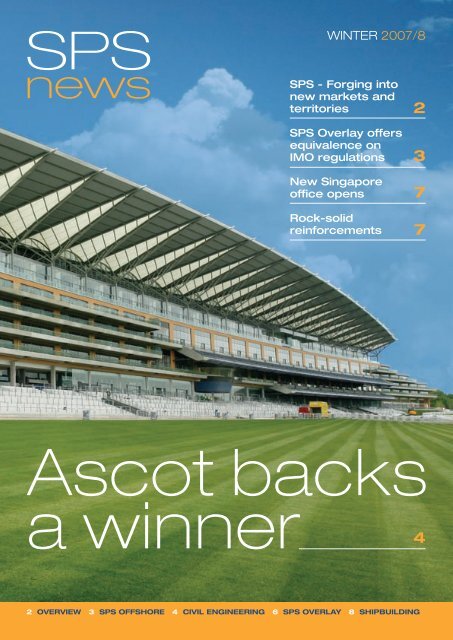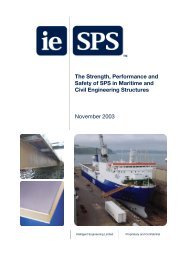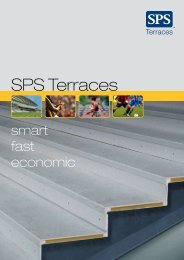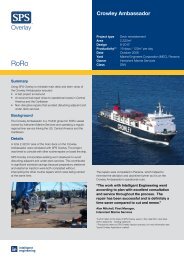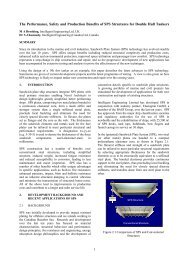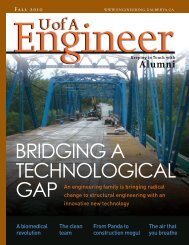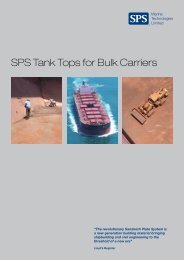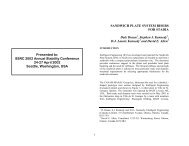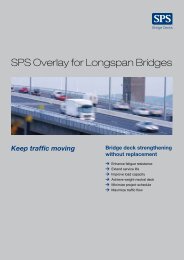Download pdf - SPS
Download pdf - SPS
Download pdf - SPS
You also want an ePaper? Increase the reach of your titles
YUMPU automatically turns print PDFs into web optimized ePapers that Google loves.
<strong>SPS</strong><br />
news<br />
WINTER 2007/8<br />
<strong>SPS</strong> - Forging into<br />
new markets and<br />
territories<br />
2<br />
<strong>SPS</strong> Overlay offers<br />
equivalence on<br />
IMO regulations<br />
New Singapore<br />
office opens<br />
Rock-solid<br />
reinforcements<br />
3<br />
7<br />
7<br />
Ascot backs<br />
a winner 4<br />
2 OVERVIEW 3 <strong>SPS</strong> OFFSHORE 4 CIVIL ENGINEERING 6 <strong>SPS</strong> OVERLAY 8 SHIPBUILDING
2 OVERVIEW<br />
<strong>SPS</strong> - A catalyst for<br />
wide-scale innovation<br />
<strong>SPS</strong> Terraces under construction at Ascot<br />
The Sandwich Plate System (<strong>SPS</strong>) is now<br />
enjoying rapid growth in the established<br />
market of ship repair and conversion. We<br />
are also making great strides in introducing<br />
<strong>SPS</strong> to new markets in civil engineering and<br />
proving more applications in the shipbuilding<br />
and offshore sectors. Let me highlight some<br />
of the milestones that have been achieved in<br />
recent months.<br />
We are delighted to have completed<br />
a major project at Ascot Racecourse,<br />
in which <strong>SPS</strong> Terraces were used to<br />
re-profile the lower grandstand. The<br />
success at Ascot was followed by<br />
a report from consulting engineers<br />
Mott MacDonald, undertaken with the<br />
assistance of leading stadia architects<br />
HOK Sport, which concludes that the<br />
weight and schedule savings available<br />
using <strong>SPS</strong> Terraces can reduce the cost<br />
of this element of a project by 30%.<br />
<strong>SPS</strong> Floors were the subject of a second study<br />
by consulting engineers Arup and quantity<br />
surveyors Gardiner & Theobald. This shows<br />
that using <strong>SPS</strong> Floors can reduce the overall<br />
weight of a typical high-rise steel-framed<br />
building by 40%, shorten the build programme<br />
by 15% and make it possible to add more<br />
floors. The economic benefit is as much as<br />
10% of the overall build cost, increasing to<br />
20% where additional floors can be included.<br />
Prefabricated <strong>SPS</strong> Terraces and <strong>SPS</strong> Floors<br />
are compatible with the modern trends toward<br />
off-site production and steel-framed structures.<br />
The engineering and economic benefits are<br />
clear and we are ready to produce at scale.<br />
<strong>SPS</strong> Terraces are available today and we<br />
expect to roll out <strong>SPS</strong> Floors early next year.<br />
We are pleased to announce the<br />
establishment of a subsidiary, <strong>SPS</strong> Overlay<br />
Asia Pte., which Denis Welch will manage<br />
from his new base in Singapore. We are<br />
doubling the volume of business in ship<br />
repair year-on-year with much of this arising<br />
in South East Asia. In a related strategic<br />
thrust, we have completed our first five ship<br />
repair projects in China.<br />
In a development that will bring benefits<br />
to both offshore and newbuilding, a<br />
recently completed study has proven<br />
that <strong>SPS</strong> Overlay offers a substantially<br />
better solution for strengthening the side<br />
shells of single-hulled FPSOs. Carried<br />
out jointly with Monaco-based Single<br />
Buoy Moorings and overseen by the<br />
American Bureau of Shipping, the study<br />
concludes that the <strong>SPS</strong>-CDS (Compact<br />
Double Shell) solution offers superior<br />
impact resistance. The use of <strong>SPS</strong> has<br />
been approved by the major classification<br />
societies as compliant with the IMO’s<br />
MEPC Circular 406 and the economic<br />
benefits have been verified by Keppel.<br />
In the shipbuilding sector, we have made<br />
important advances in the verification<br />
of connection details and construction<br />
techniques. These include the completion of<br />
a mock-up of a quarter section of the tank of<br />
a chemical carrier built in Europe and a liftable<br />
deck for a car carrier built at DSME Shipyard<br />
in Korea. These projects confirm that <strong>SPS</strong><br />
can be incorporated into existing designs and<br />
can be carried out efficiently using existing<br />
shipyard facilities. Both projects are now<br />
moving on to commercial applications.<br />
On the corporate front, I am very<br />
pleased to welcome Joanne Curin to the<br />
management team and board of IE as<br />
Chief Financial Officer. Jo has been CFO<br />
of two major public companies (P&O<br />
and Lend Lease) and brings a wealth of<br />
experience and contacts to all areas of<br />
our business.<br />
We also welcome three new Advisory Board<br />
members, Dr Peter Cheng, Sir Frank Lampl<br />
and Dr Tom Murray. Dr Cheng runs a naval<br />
architecture and marine consulting business<br />
based in Hong Kong and Shanghai. Sir Frank<br />
is a former President of Bovis Lend Lease.<br />
Dr Murray is a professor of engineering at<br />
Virginia Tech.<br />
The last year has seen some dramatic<br />
results in the take-up of <strong>SPS</strong> in established<br />
applications, such as <strong>SPS</strong> Overlay, and in<br />
the introduction of new ones, such as <strong>SPS</strong><br />
Terraces and <strong>SPS</strong> Floors. <strong>SPS</strong> has been<br />
called “the first new materials technology<br />
for heavy engineering in 150 years” and,<br />
in the early days, it was said that owners<br />
and professionals in the maritime and civil<br />
engineering industries were too conservative<br />
to take on new ideas. It seems this is<br />
not true after all. I look forward to doing<br />
business with you.<br />
Michael Kennedy<br />
CEO, Intelligent Engineering
<strong>SPS</strong> OFFSHORE 3<br />
FPSO major steel repairs<br />
Perenco’s FPSO Conkouati underwent repairs whilst<br />
on-station off the coast of the Republic of Congo<br />
A recent FPSO repair off the coast of<br />
West Africa has once again demonstrated<br />
the versatility of <strong>SPS</strong> Overlay and its<br />
scope for offshore repairs in situ.<br />
Perenco’s FPSO Conkouati, originally<br />
a single-hulled 1973-built 232,918 dwt<br />
VLCC, has had hull repairs successfully<br />
completed whilst in operation at the<br />
Yombo field, 60 miles off the coast of<br />
Point Noire in the Republic of Congo.<br />
FPSOs present a range of repair challenges<br />
to their operators, not least the fact that they<br />
are intended to remain on station and in<br />
production continuously. Conventional steel<br />
repair procedures are often not appropriate<br />
or practical for such repairs but <strong>SPS</strong> Overlay,<br />
with both low-heat and no-heat options, is<br />
quickly catching on as a flexible alternative.<br />
A total of 598m 2 of <strong>SPS</strong> Overlay was used in<br />
two places on board the FPSO Conkouati.<br />
Four areas of side shell vulnerable to<br />
impact damage where huge fenders are<br />
lowered when vessels come alongside were<br />
strengthened on the port side. And <strong>SPS</strong><br />
Overlay was also used to reinforce areas<br />
of the bottom shell in number five port and<br />
starboard cargo tanks.<br />
Miss Klervi Keryhuel, a Marine<br />
Engineer from Perenco commented,<br />
“<strong>SPS</strong> Overlay was a good choice for<br />
us. The repairs were not intrusive and<br />
were carried out on station whilst<br />
normal operations on board continued.<br />
The equipment used for the job was<br />
small and portable and meant that<br />
its movement did not cause major<br />
inconvenience or involve many people.<br />
The work is now finished with<br />
excellent results.”<br />
Denis Welch, Director <strong>SPS</strong> Overlay said,<br />
“We’ve been doing more and more FPSO<br />
repairs recently. <strong>SPS</strong> Overlay speeds up<br />
and simplifies repairs and we’re seeing<br />
a growing forward book of new FPSO<br />
business. The Conkouati was a great<br />
project for us with <strong>SPS</strong> Overlay being used<br />
for reinstatement, strengthening and impact<br />
protection. The Perenco team were great to<br />
work with.”<br />
<strong>SPS</strong> Overlay offers equivalence<br />
on IMO side impact regulations<br />
Following a study commissioned by<br />
Single Buoy Moorings and subsequent<br />
approval from leading classification<br />
societies for the use of <strong>SPS</strong> Overlay to<br />
protect the side shell structure of singleskinned<br />
FPSOs, Intelligent Engineering is<br />
gearing up for new orders.<br />
Lloyd’s Register, American Bureau of Shipping<br />
and Det Norske Veritas have all signed<br />
off on the procedure which meets IMO’s<br />
MEPC Circular 406, dated November 2003,<br />
regarding the ability to withstand low impact<br />
collision damage, and offers a range of<br />
other benefits too.<br />
Now, FPSO hulls can be strengthened<br />
using <strong>SPS</strong> Overlay on the side-shell. The<br />
resulting structure is stronger, more resistant<br />
to puncture and provides better fatigue<br />
resistance than conventionally strengthened<br />
side-shell panels.<br />
Until now, impact resistance has been<br />
improved by installing cofferdams inside the<br />
hull in the vulnerable side shell area. But<br />
this is time-consuming, expensive and gives<br />
rise to significant life-time inspection and<br />
maintenance requirements.<br />
The superior properties of <strong>SPS</strong> Overlay more<br />
than meet the IMO requirements and make<br />
side-shell strengthening a much easier and<br />
cheaper process. Conversion and life-cycle<br />
costs are therefore reduced as a result.<br />
Deadweight is also reduced.<br />
“The SBM study has confirmed what we<br />
already knew,” says Martin Brooking,<br />
Intelligent Engineering’s Engineering &<br />
Design Director. “Now we can offer FPSO<br />
operators a significantly more effective way to<br />
strengthen side-shells. It is a quicker, cheaper<br />
and altogether more effective solution. There<br />
are significant implications for other ship<br />
types too,” he says. “These findings pave<br />
the way for other cost-effective solutions<br />
to protect against collision or grounding<br />
damage, for example, or provide additional ice<br />
strengthening.”<br />
<strong>SPS</strong> Overlay can protect the side-shell of singleskinned<br />
FPSOs
4 CIVIL ENGINEERING<br />
Winner at Ascot<br />
A series of improvements to the new<br />
grandstand at Ascot Racecourse have<br />
been completed using <strong>SPS</strong> Terraces,<br />
a new product designed and patented<br />
for both the new construction and<br />
expansion of sports stadia. The Ascot<br />
alterations, which improve sight lines<br />
by increasing the rake and elevation<br />
of the terraces, have involved the<br />
manufacture of 3,250m 2 of <strong>SPS</strong> Terraces<br />
for installation in two sections.<br />
The lower section, comprising 2,600m 2 of<br />
continuous standing terracing, has been<br />
constructed with 10.5m long <strong>SPS</strong> sections<br />
supported on steel rakers. The upper section,<br />
which is made up of 25 separate units<br />
incorporating a variety of standing, seating,<br />
loge and disabled areas, is supported on a<br />
steel sub-frame clad in aluminium.<br />
The <strong>SPS</strong> Terraces were fabricated by Eiffel<br />
Deutschland Stahltechnologie (EDS), IE’s<br />
German production partner, whilst the<br />
supporting steelwork was supplied and<br />
installed by MAPSSS.<br />
Architects, engineers and contractors are<br />
finding three key benefits of using <strong>SPS</strong><br />
Terraces. Firstly, they are less than one<br />
quarter of the weight of concrete terraces<br />
and typically reduce the necessary weight<br />
of the supporting structure by over 30%.<br />
Secondly, they are three to four times faster<br />
to erect as they are lifted in banks of multiple<br />
terraces. Finally, they significantly enhance<br />
the architectural finish of the stadium.<br />
At Ascot, these weight savings meant the<br />
new <strong>SPS</strong> Terraces have been built on top of<br />
the existing structure, without the need for<br />
removal or reinforcement. A key requirement<br />
was a short build schedule, dovetailing neatly<br />
with a broader construction programme and<br />
incorporating three race meetings within the<br />
three month build schedule.<br />
Charles Barnett, Chief Executive, Ascot<br />
Racecourse, commented “There is no<br />
doubt that <strong>SPS</strong> Terraces provided the<br />
right solution for our tight timetable. IE<br />
and its partners delivered all that we were<br />
looking for. We are impressed with the<br />
high quality finish and performance of<br />
the <strong>SPS</strong> Terraces and delighted that they<br />
met with the approval of our customers at<br />
Royal Ascot this year. With such obvious<br />
speed and quality advantages, <strong>SPS</strong><br />
Terraces must have a strong future in the<br />
stadium industry.”<br />
IE Management Team and Advisory Board, Ascot Racecourse - Left to Right: Dr. Neil Little, John Ferguson,<br />
Dr Stephen Kennedy, Dr Roger Dorton, Sir Frank Lampl, Martin Brooking, Stuart Rolland, Jake Ulrich, John<br />
Redwood, Denis Welch, Prof Chengi Kuo, Dr Tom Murray, Dr Laurie Kennedy, Jeremy Lloyd, Guy Turner, Dr David<br />
Wilbraham, Dr Doug Wright, Sir Bruce MacPhail, Dr Peter Cheng, Michael Kennedy. Absent: Sir John Parker,<br />
Nicholas Lykiardopulo, George Blake, Tim Kennedy, Jo Curin<br />
The erection of the <strong>SPS</strong> Terraces used<br />
conventional construction techniques but,<br />
with fewer lifts and reduced loads, the<br />
schedule was significantly faster. At Ascot,<br />
the speed of <strong>SPS</strong> Terrace installation was<br />
well-proven, with a three-man steel crew<br />
and mobile crane achieving build rates of<br />
seventeen 10.5m terraces in under four hours.<br />
Further benefits of the new product include<br />
its appearance. It can be delivered with<br />
appropriate fittings, in any colour, giving<br />
architects freedom to continue their chosen<br />
colour scheme throughout the terraces,<br />
and avoiding the dirty grey of concrete.<br />
Factory-applied non-slip surfaces make<br />
<strong>SPS</strong> Terraces safer in the wet whilst<br />
improved water-tightness provides stadium<br />
owners with more flexibility on the use of<br />
space below.<br />
Guy Turner, IE Civil Engineering Director, said:<br />
“The physical properties of <strong>SPS</strong> Terraces are<br />
undoubtedly superior to conventional<br />
materials, with speed, weight and finish<br />
offering notable advantages. <strong>SPS</strong> Terraces<br />
now offer a cost-effective and winning<br />
alternative to concrete structures.”<br />
A bank of <strong>SPS</strong> Terraces being lifted into position
CIVIL ENGINEERING 5<br />
Prefabricated units delivered on trucks<br />
Installation uses conventional connection details<br />
All fittings easily accommodated<br />
Non-slip coating on tread<br />
New solution for a growing<br />
global market<br />
New stadiums are a growth industry. As<br />
our leisure time increases so does our<br />
need for sports and concert venues. Sports<br />
clubs especially are being driven to replace<br />
or expand their existing venues. At the same<br />
time, governing bodies are requiring higher<br />
standards before allowing major events to<br />
be held at venues. Recent reports from<br />
Deloitte & Touche and others indicate that<br />
new venues can deliver an increase of over<br />
50% in annual revenues by increasing gates<br />
and adding facilities. However, projects still<br />
face tight budgets and, with off-seasons<br />
getting shorter, contractors are being pushed<br />
to fit builds into ever tighter schedules.<br />
A recently completed independent report<br />
shows that <strong>SPS</strong> Terraces can offer projects<br />
significant economic and schedule savings to<br />
help owners meet this challenge. The report<br />
complied by HOK Sport, Mott MacDonald<br />
and Franklin Andrews, represents some of the<br />
leading global experts in stadium architecture,<br />
engineering and economics.<br />
The report assessed the benefits of using<br />
<strong>SPS</strong> Terraces instead of concrete terraces<br />
for a generic 40,000 seat steel framed<br />
football stadium in the UK. After detailed<br />
analysis, based on a grid using typical<br />
7.65m spans, they concluded that the<br />
weight of frame could be reduced by<br />
38% and the project schedule by over<br />
10%. This resulted in a saving of over<br />
£2.2m, or 16%, on an overall terracing<br />
cost of £14m. When a 15.3m span solution<br />
was considered, this saving increased<br />
to £5.5m, or 31%, on an overall cost of<br />
£17.7m. In addition, the cost of concrete<br />
terraces goes up as the span increases<br />
whereas the cost of <strong>SPS</strong> Terraces remains<br />
broadly constant. The longer span <strong>SPS</strong><br />
solution is therefore less expensive than<br />
the shorter span concrete.<br />
“This report confirms the significant economic<br />
and programme benefits that projects can<br />
secure by incorporating <strong>SPS</strong> Terraces into<br />
their designs.” says Guy Turner, IE Civil<br />
Engineering Director. “When combined with<br />
the simplicity and enhanced architectural<br />
finish demonstrated by our recent project at<br />
Ascot, it is easy to see why <strong>SPS</strong> Terraces are<br />
generating so much interest.”
6 <strong>SPS</strong> OVERLAY<br />
Stronger<br />
decks for<br />
car carriers<br />
Global vehicle distributor and logistics<br />
firm Wallenius Lines needed additional<br />
flexible cargo capacity on board three of<br />
its car carriers to enable them to handle<br />
growing volumes of increasingly important<br />
“high and heavy” cargo – trucks, tractor<br />
units and construction plant.<br />
An innovative project to lengthen the 5,873-<br />
car sister ships Don Carlos, Don Quixote<br />
and Don Pasquale by inserting a new<br />
28m midbody section provided the ideal<br />
opportunity to strengthen a 2,000m 2 area of<br />
the ships’ main decks, to give greater loading<br />
flexibility. The conversions, undertaken at<br />
Hyundai Vinashin in Vietnam, resulted in each<br />
vessel having capacity to carry approximately<br />
20% more cargo including a much larger<br />
proportion of high and heavy units.<br />
Work on board the three ships was<br />
undertaken consecutively at the Vietnam<br />
facility but V Ships’ SeaSquad riding squads<br />
prepared the vehicle carriers during their<br />
repair voyages by blasting, cleaning and<br />
preparing steel for <strong>SPS</strong> Overlay. This took<br />
Don Pasquale (above) - one of the three Wallenius Wilhelmsen vessels to undergo deck strengthening<br />
pressure off the yard and helped project<br />
managers stick to the tight 38-day timetable.<br />
IE’s licensee Keppel supported IE’s project<br />
management team and provided extra<br />
injection engineers, whilst Hyundai Vinashin<br />
itself carried out the necessary steel work,<br />
incorporating many thousands of deck<br />
fittings. In the event, steel work and elastomer<br />
injection were completed in about 15 days<br />
on each ship, well within the critical path and<br />
a fraction of the time that would have been<br />
required for conventional steel work.<br />
In a total of 105 days, the company has<br />
significant additional cargo capacity. And,<br />
with extra deck strength as a result of <strong>SPS</strong><br />
Overlay, the three ships are now capable<br />
of carrying significantly heavier cargo.<br />
This has been achieved at a fraction of<br />
the price of a new ship and about three<br />
years sooner. <strong>SPS</strong> Overlay was a key<br />
element of the project, combining speed,<br />
extra strength and versatility.<br />
Anytime, any place, anywhere<br />
repair yards – Yiu Lian, Cosco Guangzhou<br />
and Cosco Zhoushan respectively.<br />
The significance of these first Chinese repairs<br />
is notable. Even with repair yards full to<br />
bursting, steel rates in China are amongst<br />
the cheapest in the world. Yet the economics<br />
of <strong>SPS</strong> Overlay repairs still offer a convincing<br />
price-competitive outcome whether in the<br />
low-cost yards of the Chinese mainland or in<br />
the high cost facilities of northern Europe.<br />
<strong>SPS</strong> Overlay licensee, SMT, has now reinstated the tank tops of three of its fleet in China<br />
Intelligent Engineering’s China debut<br />
in early 2007, with three handymax<br />
bulk carrier projects, was another key<br />
step in establishing the indisputable<br />
economics of <strong>SPS</strong> Overlay for steel<br />
reinstatement and strengthening.<br />
All three contracts were for cargo hold tank<br />
top reinstatement. Spar Three and Spar<br />
Topaz are operated by Hong Kong based<br />
Fleet Management, whilst the third vessel,<br />
Dipper, is owned by <strong>SPS</strong> Overlay licensee,<br />
SMT. Work was carried out at three separate<br />
Denis Welch, <strong>SPS</strong> Overlay Director, explains:<br />
“We offer substantial time savings as<br />
compared with conventional crop-and-replace<br />
repair techniques. That means that yards<br />
have much more scope to make better<br />
use of their existing facilities. <strong>SPS</strong> Overlay<br />
repairs are faster and ships are in and out<br />
more quickly,” he says. “The yard raises its<br />
productivity by increasing its throughput.<br />
Furthermore, we use a fraction of the labour,<br />
allowing yards to have more work on the go<br />
at any one time.”
<strong>SPS</strong> OVERLAY 7<br />
IE opens new<br />
Asian subsidiary<br />
IE has established a new Far East<br />
subsidiary which Denis Welch, <strong>SPS</strong><br />
Overlay Director, is managing from his<br />
new Singapore base. With <strong>SPS</strong> Overlay<br />
business doubling year-on-year, and<br />
much of it coming from SE Asia, this<br />
move provides IE with an excellent centre<br />
from which to service this growth. It<br />
also enables IE to support its most<br />
established licensee, Keppel Offshore<br />
and Marine.<br />
Welch commented, “Asian yards are<br />
struggling to keep pace with ship repair<br />
demand. Due to <strong>SPS</strong> Overlay’s speed and<br />
efficiency, it is now being recognised as<br />
a means of improving productivity and<br />
yard throughput. With five projects now<br />
completed in China, we’ve shown how<br />
it can match the price of conventional<br />
steel repair and anticipate more and more<br />
projects will be completed there.”<br />
<strong>SPS</strong> Overlay Asia Pte Ltd,<br />
1 Maritime Square #09-59,<br />
Harbourfront Centre, Singapore 099253.<br />
Tel: +65 6513 2782.<br />
Deck strengthening of Van Oord’s special service<br />
vessel, Jan Steen, at Pan United Shipyard, Singapore<br />
Rock-solid reinforcement<br />
High impact resistance, durability<br />
and the superior performance of <strong>SPS</strong><br />
Overlay were key considerations in<br />
the decision by the Ras Laffan Joint<br />
Venture (RLJV) to reinforce a 2,158m 2<br />
area of deck aboard the barge Labroy<br />
237, currently on charter as a floating<br />
jetty at the vast $2bn Ras Laffan Port<br />
Expansion project in Qatar.<br />
The RLJV, comprising Jan de Nul Dredging<br />
Ltd and Boskalis Westminster ME Ltd, uses<br />
the barge as a platform over which some of<br />
the world’s largest earth-moving vehicles shift<br />
millions of tonnes of material from shore to<br />
side stone dumping vessels engaged on land<br />
reclamation works offshore.<br />
Conventional deck protection was not<br />
sufficient to withstand the gruelling routine<br />
and specifically the high point loads of<br />
the mobile plant. RLJV’s challenge was<br />
to distribute wheel loads and prevent the<br />
possible shredding of heavy plant tyres by<br />
steel reinforcement bars exposed as the<br />
concrete deck disintegrated under load<br />
“We had to find a rapid solution<br />
to strengthen the barge and avoid<br />
problems like plant damage,” explains<br />
RLJV Technical Superintendent<br />
Rene Verbrugge. “<strong>SPS</strong> Overlay has<br />
earned an excellent reputation for<br />
its impact resistance, durability<br />
and overall performance. It was an<br />
Top plates being lowered into position on board the Labroy 237 barge at Arab Heavy Industries, Ajman UAE<br />
obvious solution which could be swiftly<br />
implemented.”<br />
<strong>SPS</strong> Overlay’s high impact and puncture<br />
resistance is already well tried and tested.<br />
<strong>SPS</strong> Overlay Director Denis Welch points<br />
out that the deck of the Van Oord-owned<br />
specialist rock dumper Jan Steen,<br />
strengthened in 2004, shows virtually no<br />
signs of distress despite the fact that the<br />
vessel has carried millions of tonnes of<br />
quartz rock over the last three years.
8 SHIPBUILDING<br />
<strong>SPS</strong> new construction<br />
a step closer<br />
IE and DSME have completed the first<br />
phase of a joint industry project aimed<br />
at developing production techniques.<br />
This first project involved the design<br />
and construction of a liftable car deck<br />
as would be used on a Pure Car Carrier<br />
(PCC). At the beginning of the project<br />
IE delivered a full technical workshop<br />
to DSME staff including representatives<br />
from R&D, hull basic design and<br />
production teams. IE and DSME then<br />
worked together on the design and<br />
construction of a mock up section of the<br />
deck, which was subjected to static and<br />
dynamic load tests to calibrate against<br />
the design calculations and analysis. The<br />
collaborative work continues and future<br />
components will include light-weight<br />
car decks, accommodation blocks, tank<br />
tops and hatch covers.<br />
Completed <strong>SPS</strong> liftable car deck undergoing testing at DSME Shipyard<br />
Further newbuild opportunities<br />
Mock-up of <strong>SPS</strong> specialised chemical tanker section<br />
showing typical connection details<br />
A quarter section of the cargo tank of a<br />
specialised chemical tanker with double<br />
bottom has now been successfully<br />
completed, bringing the construction of<br />
an <strong>SPS</strong>-hulled inland waterway tanker<br />
a step closer. Built in consultation with<br />
Germanischer Lloyd and major European<br />
shipping operator, Reederei Jaegers, the<br />
objectives were to verify panel fabrication<br />
methods, to test all connection details and<br />
joints, and to verify that minimum<br />
deformation occurred.<br />
The project has provided a valuable insight<br />
into this and future <strong>SPS</strong> newbuild projects.<br />
The next phase includes revisiting the tanker’s<br />
design in light of what has been learnt before<br />
moving on to build a full-size structure.<br />
Contact Details<br />
Intelligent Engineering (UK) Ltd<br />
Shire House, West Common, Gerrards Cross,<br />
Buckinghamshire, UK. SL9 7QN.<br />
Tel: +44 1753 890 575<br />
Fax: +44 1753 899 056<br />
Intelligent Engineering (Canada) Ltd<br />
14 Chamberlain Avenue (Suite 300),<br />
Ottawa, Ontario, Canada. K1S 1V9.<br />
Tel: +1 613 569 3111<br />
Fax: +1 613 569 3222<br />
Intelligent Engineering (USA)<br />
2600 South Gessner, Suite 504<br />
Houston, TX 77063-3270, USA.<br />
Tel: +1 713 974 0186<br />
Fax: +1 713 789 1347<br />
<strong>SPS</strong> Overlay Asia Pte Ltd<br />
1 Maritime Square #09-59,<br />
Harbourfront Centre,<br />
Singapore 099253, Singapore.<br />
Tel: +65 6513 2782<br />
Fax: +65 6513 2784<br />
General Enquiries:<br />
Tel: +44 1753 890 575<br />
enquiries@ie-sps.com<br />
Civil Engineering: Guy Turner<br />
Tel: +44 8707 104 201<br />
turner@ie-sps.com<br />
Ship Repair and Offshore: Denis Welch<br />
Tel: +44 8707 107 184<br />
welch@ie-sps.com<br />
Shipbuilding: Martin Brooking<br />
Tel: +44 8707 104 202<br />
brooking@ie-sps.com<br />
Ship Repair and Offshore (Americas):<br />
James Bond<br />
Tel: +1 847 232 9338<br />
bond@ie-sps.com<br />
www.ie-sps.com


